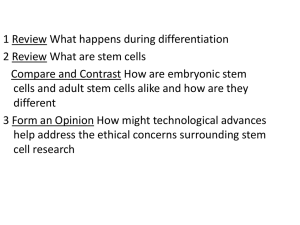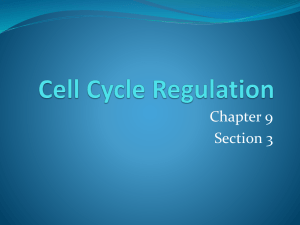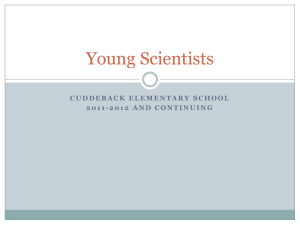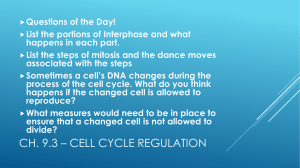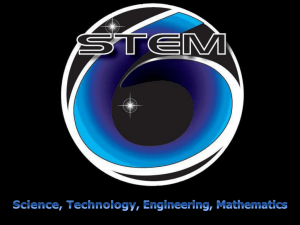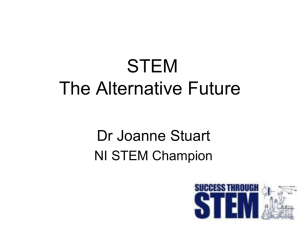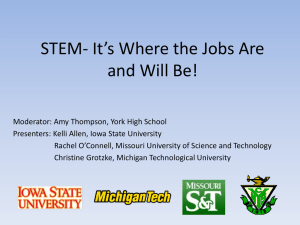Dr Asmat Salim MM 704 stem cells
advertisement
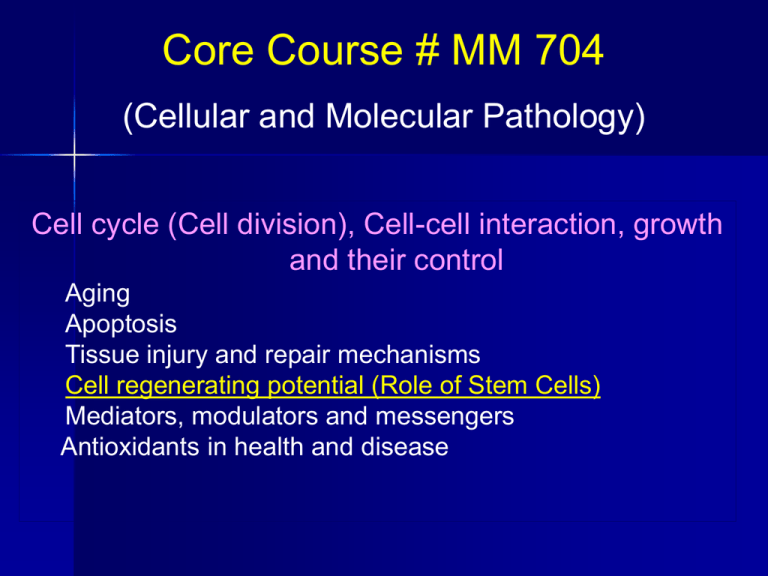
Core Course # MM 704 (Cellular and Molecular Pathology) Cell cycle (Cell division), Cell-cell interaction, growth and their control Aging Apoptosis Tissue injury and repair mechanisms Cell regenerating potential (Role of Stem Cells) Mediators, modulators and messengers Antioxidants in health and disease Outline of Lecture Stem Cells Definition Types Identification Criteria Trans-differentiation Regenerative Medicine Definition Types Potentials e.g. Regeneration of Cells and Tissues STEM CELLS Stem Cells Three general properties: (1) are unspecialized (2) capable of dividing and renewing themselves for long periods (proliferation) (3) can give rise to specialized cell types (differentiation) Definition: Stem cells are primary cells present in all multicellular organisms that retain the ability or potential to renew themselves through cell division and can differentiate into a wide range of specialized cell types Types of Stem Cells on the basis of their Differentiation Potential (1) Totipotent: have the potential to become any cell type in the body. are produced from the fusion of an egg and sperm cell. (2) Pluripotent: are derived from totipotent cells. have the potential to make any differentiated cell in the body (but not all). (3) Multipotent: can only differentiate into a limited number of types or can produce only cells of a closely related family of cells e.g. hematopoietic stem cells. (4) Unipotent cells can produce only one cell type, but have the property of self-renewal which distinguishes them from non-stem cells. Stem Cells and their Differentiation Potential Types of Stem Cells on the basis of their Source Embryonic Stem Cells Adult Stem Cells Embryonic Stem Cells are derived from inner cell mass of four or five days old embryos unique ability of unlimited expansion are a potential source for regenerative medicine and tissue replacement after injury or disease Sources of Embryonic Stem Cells 1. Excess fertilized eggs from IVF (in-vitro fertilization) clinics 2. Therapeutic cloning (somatic cell nuclear transfer) Tens of thousands of frozen embryos are routinely destroyed. These surplus embryos can be used to produce stem cells. The nucleus of a donated egg is removed and replaced with the nucleus of a mature, "somatic cell" (a skin cell, for example). The resulting stem cells can potentially develop into specialized cells that are useful for treating severe illnesses. Identification of Embryonic Stem Cells Long-term self-renewal Undifferentiated for long periods Presence of surface markers found only on undifferentiated cells e.g. Oct-4 Pluripotent state by allowing cells to differentiate spontaneously in cell culture; manipulating cells so they will differentiate to form specific cell types; or injecting cells into an immuno-suppressed mouse to test for the formation of a benign tumor called a teratoma Trans-differentiation property (Plasticity) Advantages: can become all cell types of the body can be relatively easily grown in culture Disadvantages: Safety and effectiveness in humans is controversial They can grow out-of-control forming tumors They can change into unintended types of cells They can cause transplant rejection Adult Stem Cells undifferentiated cells found among differentiated cells in a tissue or organ can renew themselves can differentiate to yield major specialized cell types of the tissue or organ maintain and repair the tissue in which they are found Types of Adult Stem Cells Bone Marrow Adipose Tissue Cord Blood Liver Muscle Brain Placenta Pancreas Retina Skin Hematopoeitic Stem Cells Mesenchymal Stem Cells or Stromal Cells Identification of Adult Stem Cells cKit CD44 CD90 Western Blotting Immuno-cytochemistry Flow Cytometry Cardiovasc Ther. 2012 Jun 15. doi: 10.1111/j.1755-5922.2012.00320.x Trans-differentiation Potential of Adult Stem Cells Advantages: No danger of immune rejection with cells from the patient's own body Extremely low risk of tumor growth Easier to control than embryonic cells No significant ethical issues Disadvantages: present in the body in very small numbers more limited in differentiation than embryonic cells Induced Pluripotent Stem Cells (iPSCs) Adult cells genetically reprogrammed to an embryonic stem cell–like state by introducing specific genes through viruses Mouse iPSCs were first reported in 2006, and human iPSCs were first reported in late 2007 Mouse and Human iPSCs demonstrate characteristics of pluripotent stem cells, e.g. stem cell markers, generate cells of all three germ layers Tissues derived from iPSCs will be a nearly identical match to the cell donor and thus probably avoid rejection by the immune system This discovery has created a powerful new way to “dedifferentiate” cells whose developmental fates had been previously assumed to be determined REGENERATIVE MEDICINE Definition: A technique to replace, repair, maintain or enhance tissue or organ functions by in vitro design while in vivo usage Why do we use Regenerative Medicine Most human tissues do not regenerate spontaneously Parkinson's disease Spinal cord injury IDDM Multiple Sclerosis (MS) Myocardial Infarction Types of regenerative medicine 1. Cell Therapy 2. Tissue Engineering Cells and Tissues in Regenerative Medicine Reconstructive Surgery 1. a. growing suitable cells (e.g. adult stem cells) in laboratory flasks b. Injecting them directly into a tissue needing repair or into the blood stream (homing to the site of injury) (Cell Therapy) 2. building an organ or tissue outside the body e.g. scaffold-like structure (Tissue Engineering) Cell Therapy Transplantation of human or animal cells to replace or repair damaged tissue and/or cells. Applications to rebuild damaged cartilage in joints repair spinal cord injuries autoimmune diseases (AIDS) neurological disorders (Alzheimer‘s disease, Parkinson's disease, etc). Tissue Engineering The regeneration of biological tissues through the use of cells, with the aid of supporting structures and/or biomolecules. Culture, expansion and/or differentiation of the cells Regenerated tissue transplanted into the body Scaffold: Characteristics The scaffold should mimic the structure and biological function of native extra cellular matrix (ECM) The structures can vary from sponge like sheets and fabrics to gels or highly complex structures Scaffolds are porous. The porosity of the scaffold and interconnectivity of the pores enable cell penetration into the structure as well as the transport of nutrients and waste products Degradable structures fabricated from either natural materials or synthetic polymers (J.Cell.Mol.Med. Vol. 11,654-69, 2007) Skin Regeneration (Nature Vol. 414,118-121, 2001) Bone Regeneration (Nature Vol. 414,118-121, 2001) (J.Cell.Mol.Med. Vol. 11,654-69, 2007) Cardiac Regeneration Myogenic transdifferentiation of MSC at 4 weeks after cell transplantation FITC actinin staining Red PKH26 staining DAPI Nuclear staining Merge Circulation Res. Vol 99, 776-784. 2006 Small Molecules and Stem Cells Direct Differentiation of ES Cells Direct Differentiation of MSCs Differentiation of the Adult Stem Cells into Cardiac like cells by Small Molecules Cardiovasc Ther. 2012 Jun 15. doi: 10.1111/j.1755-5922.2012.00320.x References http://stemcells.nih.gov/info/Pages/Default.aspx Cardiovasc Ther. 2012 Jun 15. doi: 10.1111/j.1755 5922.2012.00320.x Circulation Res. Vol 99, 776-84. 2006 Nature Vol. 414,118-21, 2001 J.Cell.Mol.Med. Vol. 11,654-69, 2007


